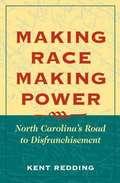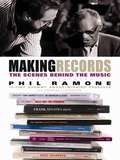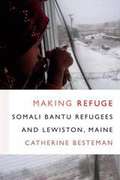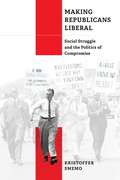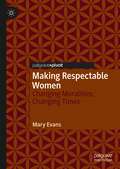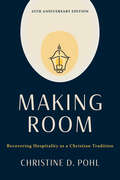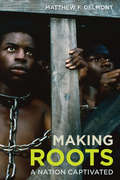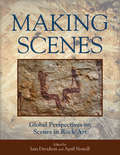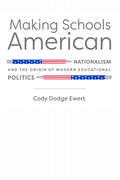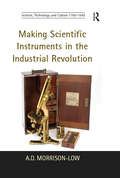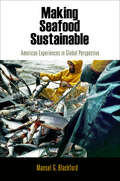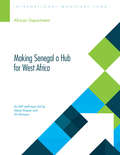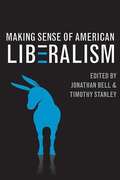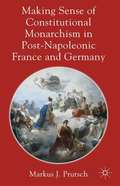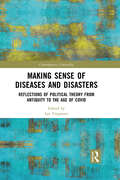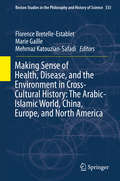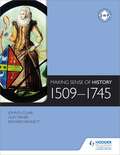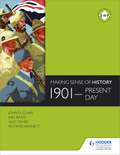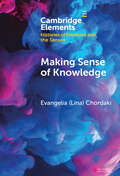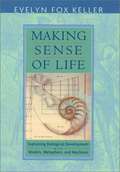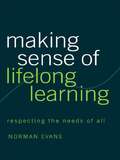- Table View
- List View
Making Race, Making Power: North Carolina's Road to Disfranchisement
by Kent ReddingIn this groundbreaking study, Kent Redding examines the fluid political landscape of the nineteenth-century South, revealing the complex interplay between the elite’s manipulation of political and racial identity and the innovative mobilizing strategies marginalized groups adopted in order to combat disfranchisement. Far from being a low-level, localized trend, the struggle for power in North Carolina would be felt across the entire country as race-and class-based organizing challenged the dominant models of making and holding power. Redding reveals how the ruling class operates with motivations and methods very similar to those of the black voters and Populist farmers they fought against. He tracks how the elites co-opted the innovative mobilizing strategies of the subaltern groups to effectively use their own weapons against them. At the core of Making Race, Making Power is an insightful dissection of the concrete connections between political strategies of solidarity and exclusion and underlying patterns of race relations.
Making Records: The Scenes Behind the Music
by Phil RamoneSinatra. Streisand. Dylan. Pavarotti. McCartney. Sting. Madonna. What do these musicians have in common besides their super-stardom? They have all worked with legendary music producer Phil Ramone.For almost five decades, Phil Ramone has been a force in the music industry. He has produced records and collaborated with almost every major talent in the business. There is a craft to making records, and Phil has spent his life mastering it. For the first time ever, he shares the secrets of his trade.Making Records is a fascinating look "behind the glass" of a recording studio. From Phil's exhilarating early days recording jazz and commercial jingles at A&R, to his first studio, and eventual legendary producer status, Phil allows you to sit in on the sessions that created some of the most memorable music of the 20th century--including Frank Sinatra's Duets album, Bob Dylan's Blood on the Tracks, Ray Charles's Genius Loves Company and Paul Simon's Still Crazy After All These Years.In addition to being a ringside seat for contemporary popular music history, Making Records is an unprecedented tutorial on the magic behind what music producers and engineers do. In these pages, Phil offers a rare peek inside the way music is made . . . illuminating the creative thought processes behind some of the most influential sessions in music history.This is a book about the art that is making records--the way it began, the way it is now, and everything in between.
Making Refuge: Somali Bantu Refugees and Lewiston, Maine
by Catherine BestemanHow do people whose entire way of life has been destroyed and who witnessed horrible abuses against loved ones construct a new future? How do people who have survived the ravages of war and displacement rebuild their lives in a new country when their world has totally changed? In Making Refuge Catherine Besteman follows the trajectory of Somali Bantus from their homes in Somalia before the onset in 1991 of Somalia's civil war, to their displacement to Kenyan refugee camps, to their relocation in cities across the United States, to their settlement in the struggling former mill town of Lewiston, Maine. Tracking their experiences as "secondary migrants" who grapple with the struggles of xenophobia, neoliberalism, and grief, Besteman asks what humanitarianism feels like to those who are its objects and what happens when refugees move in next door. As Lewiston's refugees and locals negotiate coresidence and find that assimilation goes both ways, their story demonstrates the efforts of diverse people to find ways to live together and create community. Besteman's account illuminates the contemporary debates about economic and moral responsibility, security, and community that immigration provokes.
Making Republicans Liberal: Social Struggle and the Politics of Compromise (Politics and Culture in Modern America)
by Kristoffer SmemoMass movements and social protest forced mid-century Republicans to articulate their own form of liberalismAs poor and working people organized themselves on the job, in the streets, and at the polls during the mid-twentieth century, they forced Republicans to reckon with new demands for political and social citizenship in big cities across the Northeast, Midwest, and Pacific Coast. While rightwing Republicans mobilized to crush those movements, Making Republicans Liberal explores how another wing of the party responded to intensifying mass movement pressure. Beginning in the 1930s, Republican governors such as Earl Warren of California, George Romney of Michigan, and Nelson Rockefeller of New York spent the next four decades articulating their own vision of liberalism. These Republican liberals believed that strategically they could not win elections and govern in places where unions, civil rights groups, and other social movements organized voters.What may have begun as an opportunistic strategy soon mutated into an ideological commitment to use state power to realize working people’s demands for a greater say, and stake, in the decisions governing their lives. Republican liberals accepted labor’s right to organize, legislated antidiscrimination laws, and legalized abortion. Yet at the same time, each of those policies proved weaker than the alternatives supported by organized labor or mainline civil rights groups and paled in comparison to what people on strike and on the march really wanted. Kristoffer Smemo shows how this was the contradiction of Republican liberalism as a policy program and as an ideology. The reforms it ushered in at once asked too much from core, conservative Republican constituencies and offered too little to the movements struggling for change. As the movements making Republicans compromise fragmented and collapsed in the late twentieth century, so too did the material foundation for Republican liberalism.
Making Respectable Women: Changing Moralities, Changing Times
by Mary EvansThis book studies the ways in which the assessment of being or not being ‘respectable’ has been applied to women in the UK in the past one hundred and fifty years. Mary Evans shows how the term ‘respectable’ has changed and how, most importantly, the basis of the ways in which the respectability of women has been judged has shifted from a location in women’s personal, domestic and sexual behaviour to that of how women engage in contemporary forms of citizenship, not the least of which is paid work. This shift has important social and political implications that have seldom been explored: amongst these are the growing marginalisation of the validation of the traditional care work of women, the assumption that paid work is implicitly and inevitably empowering and the complex ways in which respectability and conformity to highly sexualised conventions about female appearance have been normalised. Making Respectable Women makes use of archive material to show how the changing definition of a moral and social concept can have an impact on both the behaviour and the choices of individuals and the operations of institutional power. It will be of interest to students and scholars across the humanities and social sciences.
Making Revolution: My Life in the Black Panther Party
by Field Marshal Don CoxMaking Revolution is Don Cox’s revelatory, even incendiary account of his years in the Black Panther Party. He had participated in many peaceful Bay Area civil rights protests but hungered for more militant action. His book tells the story of his work as the party’s field marshal in charge of gunrunning to planning armed attacks—tales which are told for the first time in this remarkable memoir—to his star turn raising money at the Manhattan home of Leonard Bernstein (for which he was famously mocked by Tom Wolfe in Radical Chic and Mau-Mauing the Flak Catchers), to his subsequent flight to Algeria to join Eldridge Cleaver in exile, to his decision to leave the party following his disillusionment with Huey P. Newton’s leadership. Cox would live out the rest of his life in France, where he wrote these unrepentant recollections in the early 1980s, enjoining his daughter to promise him that she would do everything she could to have them published.
Making Room, 25th anniversary edition: Recovering Hospitality as a Christian Tradition
by Christine D. PohlHospitality is crucial to Christian ministry. To the early Christians, hospitality was central to the gospel mission. This hospitality did not consist of entertaining neighbors, but welcoming the stranger, especially those who could not return the favor. Yet despite urgent need, hospitality has fallen by the wayside. Christine Pohl&’s classic work, Making Room, first spoke to this issue in 1999. And it is just as relevant today, with the refugee crisis, the rise in homelessness, and growing loneliness and isolation. This revitalized edition, with a new foreword and afterword by the author, introduces the theology of hospitality to a new generation. Pohl combines rich biblical and historical research with experience in contemporary Christian communities, including the Catholic Worker, L&’Abri, Good Works, Inc., and others. Pragmatic and thoughtful, Pohl deals frankly with both the blessings and the boundaries of hospitality. Readers will find a wealth of wisdom to revive authentic hospitality in their ministry.
Making Roots: A Nation Captivated
by Matthew F. DelmontWhen Alex Haley's book Roots was published by Doubleday in 1976 it became an immediate bestseller. The television series, broadcast by ABC in 1977, became the most popular miniseries of all time, captivating over a hundred million Americans. For the first time, Americans saw slavery as an integral part of the nation's history. With a remake of the series in 2016 by A&E Networks, Roots has again entered the national conversation. In Making "Roots," Matthew F. Delmont looks at the importance, contradictions, and limitations of mass culture and examines how Roots pushed the boundaries of history. Delmont investigates the decisions that led Alex Haley, Doubleday, and ABC to invest in the story of Kunta Kinte, uncovering how Haley's original, modest book proposal developed into an unprecedented cultural phenomenon.
Making Scenes: Global Perspectives on Scenes in Rock Art
by Iain Davidson and April NowellDating back to at least 50,000 years ago, rock art is one of the oldest forms of human symbolic expression. Geographically, it spans all the continents on Earth. Scenes are common in some rock art, and recent work suggests that there are some hints of expression that looks like some of the conventions of western scenic art. In this unique volume examining the nature of scenes in rock art, researchers examine what defines a scene, what are the necessary elements of a scene, and what can the evolutionary history tell us about storytelling, sequential memory, and cognitive evolution among ancient and living cultures?
Making Schools American: Nationalism and the Origin of Modern Educational Politics
by Cody D. EwertHow school reformers in the Progressive Era—who envisioned the public school as the quintessential American institution—laid the groundwork for contemporary battles over the structure and curriculum of public schools.Around the turn of the twentieth century, a generation of school reformers began touting public education's unique capacity to unite a diverse and diffuse citizenry while curing a broad swath of social and political ills. They claimed that investing in education would equalize social and economic relations, strengthen democracy, and create high-caliber citizens equipped for the twentieth century, all while preserving the nation's sacred traditions. More than anything, they pitched the public school as a quintessentially American institution, a patriotic symbol in its own right—and the key to perfecting the American experiment.In Making Schools American, Cody Dodge Ewert makes clear that nationalism was the leading argument for schooling during the Progressive Era. Bringing together case studies of school reform crusades in New York, Utah, and Texas, he explores what was gained—and lost—as efforts to transform American schools evolved across space and time. Offering fresh insight into the development and politicization of public schooling in America, Ewert also reveals how reformers' utopian visions and lofty promises laid the groundwork for contemporary battles over the mission and methods of American public schools. Despite their divergent political visions and the unique conditions of the states, cities, and individual districts they served, school reformers wielded nationalistic rhetoric that made education a rallying point for Americans across lines of race, class, religion, and region. But ultimately, Making Schools American argues, upholding education as a potential solution to virtually every societal problem has hamstrung broader attempts at social reform while overburdening schools.
Making Scientific Instruments in the Industrial Revolution (Science, Technology and Culture, 1700-1945)
by A.D. Morrison-LowAt the start of the Industrial Revolution, it appeared that most scientific instruments were made and sold in London, but by the time of the Great Exhibition in 1851, a number of provincial firms had the self-confidence to exhibit their products in London to an international audience. How had this change come about, and why? This book looks at the four main, and two lesser, English centres known for instrument production outside the capital: Birmingham, Liverpool, Manchester and Sheffield, along with the older population centres in Bristol and York. Making wide use of new sources, Dr Morrison-Low, curator of history of science at the National Museums of Scotland, charts the growth of these centres and provides a characterisation of their products. New information is provided on aspects of the trade, especially marketing techniques, sources of materials, tools and customer relationships. From contemporary evidence, she argues that the principal output of the provincial trade (with some notable exceptions) must have been into the London marketplace, anonymously, and at the cheaper end of the market. She also discusses the structure and organization of the provincial trade, and looks at the impact of new technology imported from other closely-allied trades. By virtue of its approach and subject matter the book considers aspects of economic and business history, gender and the family, the history of science and technology, material culture, and patterns of migration. It contains a myriad of stories of families and firms, of entrepreneurs and customers, and of organizations and arms of government. In bringing together this wide range of interests, Dr Morrison-Low enables us to appreciate how central the making, selling and distribution of scientific instruments was for the Industrial Revolution.
Making Seafood Sustainable
by Mansel G. BlackfordIn the spring of 2007, National Geographic warned, "The oceans are in deep blue trouble. From the northernmost reaches of the Greenland Sea to the swirl of the Antarctic Circle, we are gutting our seas of fish." There were legitimate grounds for concern. After increasing more than fourfold between 1950 and 1994, the global wild fish catch reached a plateau and stagnated despite exponential growth in the fishing industry. As numerous scientific reports showed, many fish stocks around the world collapsed, creating a genuine global overfishing crisis.Making Seafood Sustainable analyzes the ramifications of overfishing for the United States by investigating how fishers, seafood processors, retailers, government officials, and others have worked together to respond to the crisis. Historian Mansel G. Blackford examines how these players took steps to make fishing in some American waters, especially in Alaskan waters, sustainable. Critical to these efforts, Blackford argues, has been government and industry collaboration in formulating and enforcing regulations. What can be learned from these successful experiences? Are they applicable elsewhere? What are the drawbacks? Making Seafood Sustainable addresses these questions and suggests that sustainable seafood management can be made to work. The economic and social costs incurred in achieving sustainable resource usage are significant, but there are ways to mitigate them. More broadly, this study illustrates ways to manage commonly held natural resources around the world--land, water, oil, and so on--in sustainable ways.
Making Senegal a Hub for West Africa
by Alexei Kireyev Ali MansoorThis Departmental Paper takes stock of Senegal's achievements in the past few years under IMF-supported programs and identifies key reform pillars for the future. IMF staff analyses Senegal's new development strategy, Plan Sénégal Emergent, which aims to make Senegal an emerging market economy by 2035.
Making Sense of American Liberalism
by Jonathan Bell Timothy StanleyThis collection of thoughtful and timely essays offers refreshing and intelligent new perspectives on postwar American liberalism. Sophisticated yet accessible, Making Sense of American Liberalism challenges popular myths about liberalism in the United States. The volume presents the Democratic Party and liberal reform efforts such as civil rights, feminism, labor, and environmentalism as a more united, more radical force than has been depicted in scholarship and the media emphasizing the decline and disunity of the left. Distinguished contributors assess the problems liberals have confronted in the twentieth century, examine their strategies for reform, and chart the successes and potential for future liberal reform. Contributors are Anthony J. Badger, Jonathan Bell, Lizabeth Cohen, Susan Hartmann, Ella Howard, Bruce Miroff, Nelson Lichtenstein, Doug Rossinow, Timothy Stanley, and Timothy Thurber.
Making Sense of Ballistic Missile Defense: An Assessment of Concepts and Systems for U.S. Boost-Phase Missile Defense in Comparison to Other Alternatives
by Committee on an Assessment of Concepts Systems for U.S. Boost-Phase Missile Defense in Comparison to Other AlternativesThe Committee on an Assessment of Concepts and Systems for U. S. Boost-Phase Missile Defense in Comparison to Other Alternatives set forth to provide an assessment of the feasibility, practicality, and affordability of U. S. boost-phase missile defense compared with that of the U. S. non-boost missile defense when countering short-, medium-, and intermediate-range ballistic missile threats from rogue states to deployed forces of the United States and its allies and defending the territory of the United States against limited ballistic missile attack. To provide a context for this analysis of present and proposed U. S. boost-phase and non-boost missile defense concepts and systems, the committee considered the following to be the missions for ballistic missile defense (BMD): protecting of the U. S. homeland against nuclear weapons and other weapons of mass destruction (WMD); or conventional ballistic missile attacks; protection of U. S. forces, including military bases, logistics, command and control facilities, and deployed forces, including military bases, logistics, and command and control facilities. They also considered deployed forces themselves in theaters of operation against ballistic missile attacks armed with WMD or conventional munitions, and protection of U. S. allies, partners, and host nations against ballistic-missile-delivered WMD and conventional weapons. Consistent with U. S. policy and the congressional tasking, the committee conducted its analysis on the basis that it is not a mission of U. S. BMD systems to defend against large-scale deliberate nuclear attacks by Russia or China. Making Sense of Ballistic Missile Defense: An Assessment of Concepts and Systems for U. S. Boost-Phase Missile Defense in Comparison to Other Alternatives suggests that great care should be taken by the U. S. in ensuring that negotiations on space agreements not adversely impact missile defense effectiveness. This report also explains in further detail the findings of the committee, makes recommendations, and sets guidelines for the future of ballistic missile defense research.
Making Sense of Constitutional Monarchism in Post-Napoleonic France and Germany
by Markus J. PrutschThe collapse of the Napoleonic order in 1814 symbolised a victory over revolutionary principles, yet it was impossible to turn the clock back and negate the legacy of the Revolution and the Napoleonic age. Could monarchical claims for personal government be realistically reconciled with the legacy of the Revolution? This dilemma gave rise to the concept of a genuinely 'monarchical' form of political rule in Europe, which distinguished itself not only from absolutism and revolutionary constitutionalism, but also British parliamentarianism. Focusing on the genesis of 'constitutional monarchism' in the context of the French Restoration and its favourable reception in post-Napoleonic Germany, this study highlights the potential and limitations of the daring attempt to improve traditional forms of monarchical legitimacy by means of a modern representative constitution. With historical, legal and politico-theoretical aspects equally examined, this work contributes towards a clearer understanding both of the 19th century and European constitutionalism.
Making Sense of Diseases and Disasters: Reflections of Political Theory from Antiquity to the Age of COVID (Contemporary Liminality)
by Lee TrepanierThis book examines diseases and disasters from the perspective of social and political theory, exploring the ways in which political leaders, social activists, historians, philosophers, and writers have tried to make sense of the catastrophes that have plagued humankind from Thucydides to the present COVID pandemic. By adopting the perspective of political theory, it sheds light on what these individuals and events can teach us about politics, society, and human nature, as well as the insights and limitations of political theory. Including thinkers such as Thucydides, Sophocles, Augustine, Bacon, Locke, Hume, Rousseau, Publius, Bartolomé de las Casas, Jane Addams, Camus, Saramago, Baudrillard, Weber, Schmitt, Voegelin and Agamben, it considers a diverse range of events including the plagues of Byzantium and 14th century Europe, 9/11, the hurricanes of Fukushima, Boxing Day, and New Orleans, and the current COVID pandemic. An examination of past, present, and future diseases and disasters, and the ways in which individuals and societies react to them, this volume will appeal to scholars of politics, sociology, anthropology and philosophy with interests in disaster and the social body.
Making Sense of Health, Disease, and the Environment in Cross-Cultural History: The Arabic-Islamic World, China, Europe, and North America (Boston Studies in the Philosophy and History of Science #333)
by Florence Bretelle-Establet Mehrnaz Katouzian-Safadi Marie GailleThis book has been defined around three important issues: the first sheds light on how people, in various philosophical, religious, and political contexts, understand the natural environment, and how the relationship between the environment and the body is perceived; the second focuses on the perceptions that a particular natural environment is good or bad for human health and examines the reasons behind such characterizations ; the third examines the promotion, in history, of specific practices to take advantage of the health benefits, or avoid the harm, caused by certain environments and also efforts made to change environments supposed to be harmful to human health. The feeling and/or the observation that the natural environment can have effects on human health have been, and are still commonly shared throughout the world. This led us to raise the issue of the links observed and believed to exist between human beings and the natural environment in a broad chronological and geographical framework. In this investigation, we bring the reader from ancient and late imperial China to the medieval Arab world up to medieval, modern, and contemporary Europe. This book does not examine these relationships through the prism of the knowledge of our modern contemporary European experience, which, still too often, leads to the feeling of totally different worlds. Rather, it questions protagonists who, in different times and in different places, have reflected, on their own terms, on the links between environment and health and tries to obtain a better understanding of why these links took the form they did in these precise contexts. This book targets an academic readership as well as an “informed audience”, for whom present issues of environment and health can be nourished by the reflections of the past.
Making Sense of History: 1509-1745
by Alec Fisher Richard Kennett John ClareDeliver engaging, enquiry-driven lessons and help pupils gain a coherent chronological understanding of and across periods studied with this complete offering for Key Stage 3 History. Designed for the 2014 National Curriculum this supportive learning package makes history fun and inspiring to learn. Making Sense of History consists of four Pupil's Books with accompanying Dynamic Learning Teaching and Learning resources. Structured around big picture overviews and in-depth enquiries on different topics, the course develops pupils understanding of history and their ability to ask and explore valid historical questions about the past.- Help pupils come to a sound chronological understanding of the past and identify the most significant events, connections and patterns of change and continuity with specifically tailored big pictures of the period and of the topics within it.- Develop pupils' enquiry skills and help them become motivated and curious to learn about the past with purposeful and engaging enquiries and a focus on individuals' lives.- Ensure pupils' progress in their historical thinking through clear and balanced targeted coverage of the main second order concepts in history.- Support and stretch your pupils with differentiated material, including writing frames to support literacy and ideas for more challenge provided in the Dynamic Learning Teaching and Learning Resources.- Make assessment become a meaningful and manageable process through bespoke mark schemes for individual pieces of work.
Making Sense of History: 1509-1745
by Alec Fisher Richard Kennett John ClareDeliver engaging, enquiry-driven lessons and help pupils gain a coherent chronological understanding of and across periods studied with this complete offering for Key Stage 3 History. Designed for the 2014 National Curriculum this supportive learning package makes history fun and inspiring to learn. Making Sense of History consists of four Pupil's Books with accompanying Dynamic Learning Teaching and Learning resources. Structured around big picture overviews and in-depth enquiries on different topics, the course develops pupils understanding of history and their ability to ask and explore valid historical questions about the past.- Help pupils come to a sound chronological understanding of the past and identify the most significant events, connections and patterns of change and continuity with specifically tailored big pictures of the period and of the topics within it.- Develop pupils' enquiry skills and help them become motivated and curious to learn about the past with purposeful and engaging enquiries and a focus on individuals' lives.- Ensure pupils' progress in their historical thinking through clear and balanced targeted coverage of the main second order concepts in history.- Support and stretch your pupils with differentiated material, including writing frames to support literacy and ideas for more challenge provided in the Dynamic Learning Teaching and Learning Resources.- Make assessment become a meaningful and manageable process through bespoke mark schemes for individual pieces of work.
Making Sense of History: 1901-present day
by Alec Fisher Richard Kennett John Clare Neil BatesDeliver engaging, enquiry-driven lessons and help pupils gain a coherent chronological understanding of and across periods studied with this complete offering for Key Stage 3 History. Designed for the 2014 National Curriculum this supportive learning package makes history fun and inspiring to learn. Making Sense of History consists of four Pupil's Books with accompanying Dynamic Learning Teaching and Learning resources. Structured around big picture overviews and in-depth enquiries on different topics, the course develops pupils understanding of history and their ability to ask and explore valid historical questions about the past.- Help pupils come to a sound chronological understanding of the past and identify the most significant events, connections and patterns of change and continuity with specifically tailored big pictures of the period and of the topics within it.- Develop pupils' enquiry skills and help them become motivated and curious to learn about the past with purposeful and engaging enquiries and a focus on individuals' lives.- Ensure pupils' progress in their historical thinking through clear and balanced targeted coverage of the main second order concepts in history.- Support and stretch your pupils with differentiated material, including writing frames to support literacy and ideas for more challenge provided in the Dynamic Learning Teaching and Learning Resources.- Make assessment become a meaningful and manageable process through bespoke mark schemes for individual pieces of work.
Making Sense of History: 1901-present day
by Alec Fisher Richard Kennett John Clare Neil BatesDeliver engaging, enquiry-driven lessons and help pupils gain a coherent chronological understanding of and across periods studied with this complete offering for Key Stage 3 History. Designed for the 2014 National Curriculum this supportive learning package makes history fun and inspiring to learn. Making Sense of History consists of four Pupil's Books with accompanying Dynamic Learning Teaching and Learning resources. Structured around big picture overviews and in-depth enquiries on different topics, the course develops pupils understanding of history and their ability to ask and explore valid historical questions about the past.- Help pupils come to a sound chronological understanding of the past and identify the most significant events, connections and patterns of change and continuity with specifically tailored big pictures of the period and of the topics within it.- Develop pupils' enquiry skills and help them become motivated and curious to learn about the past with purposeful and engaging enquiries and a focus on individuals' lives.- Ensure pupils' progress in their historical thinking through clear and balanced targeted coverage of the main second order concepts in history.- Support and stretch your pupils with differentiated material, including writing frames to support literacy and ideas for more challenge provided in the Dynamic Learning Teaching and Learning Resources.- Make assessment become a meaningful and manageable process through bespoke mark schemes for individual pieces of work.
Making Sense of Knowledge: Feminist Epistemologies in the Greek Birth Control Movement (1974–1986) (Elements in Histories of Emotions and the Senses)
by Evangelia (Lina) ChordakiWhat counts as knowledge, expertise, and theory? How are knowledge hierarchies connected to emotional and hierarchies of subjects? How does the division between emotion and reason shape our experiences? The Element addresses these questions by exploring the Greek feminist birth control movement (1974–1986), focusing on the production and circulation of knowledge, termed as affective epistemologies of antimilima (talking back). This concept reinterprets women's lived and embodied knowledge, emerging at the intersection of academia and social movements, as a form of resistance against established expertise. By drawing on feminist theorists like Donna Haraway and Sara Ahmed, the Element critically examines the relationship between scientific and experiential knowledge. This analysis reconfigures the interplay between rationality and emotion, providing a critique to the binary model of thought and suggesting new avenues for democratic knowledge, society, and citizenship. Historical tracing of these theories offers a counter-narrative to contemporary anti-gender, anti-intellectual, and far-right politics.
Making Sense of Life: Explaining Biological Development with Models, Metaphors, and Machines
by Evelyn Fox KellerA history of the diverse and changing nature of biological explanation in a particularly charged field, "Making Sense of Life" draws readers attention to the temporal, disciplinary, and cultural components of what biologists mean, and what they understand, when they propose to explain life. Illustrations. Copyright © Libri GmbH. All rights reserved.
Making Sense of Lifelong Learning: Respecting The Needs Of All
by Norman EvansMaking Sense of Lifelong Learning looks beyond the rhetoric about lifelong learning (LLL), and asks long overdue questions such as, Who is actually in need of LLL? What are the motives of institutions, employers and the Government in promoting LLL? And, who says what is and what is not LLL?In the context of the previous government attempts to enhance the economic strength of the country, the author also makes suggestions as to what might be done to encourage wider participation in LLL, particularly with regard to the increasing economic and social gaps in today's society. The considerable demographic changes to the workplace have affected the entire population, and yet employers, the government and the individual all have very different expectations from LLL. It is this previously unchallenged 'mismatch' that is one of the central themes of the book.
